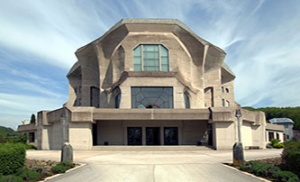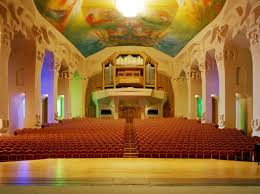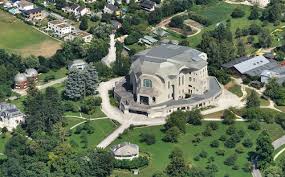About
Anthroposophy is a way of knowledge which undertakes to guide the spiritual in man to the spiritual in the universe. Anthroposophy does not seek to impart knowledge; rather, it seeks to awaken life!
Click here for more about the Boston branch. Click here for events. Some past events were recorded and may be viewed here.
What is the Anthroposophical Society?
It is an association of people whose will it is to nurture the life of the soul, both in the individual and in human society, on the basis of a true knowledge of the spiritual world. The Anthroposophical Society in Greater Boston is a branch of the Anthroposophical Society in America which is part of the Anthroposophical Society headquartered in Dornach, Switzerland.
The Anthroposophical Society was founded at the Christmas Conference of 1923/1924 in Switzerland by Rudolf Steiner (1861-1925). More about the Society and its worldwide activities can be found here.
Anyone can become a member, without regard to nationality, social standing, religion, who considers as justified the existence of an institution such as the Goetheanum in Dornach in its capacity as a School of Spiritual Science. One can also join the Facebook group Anthroposophy.
What is the Anthroposophical Society in Greater Boston?
We are a branch of the Anthroposophical Society in America serving the greater Boston area. Click here for more about the Boston branch and its activities.
As a 501(c)3 nonprofit organization, all of our activities are supported by gifts and contributions. Typical contributions are $30 per individual or $50 per family per year. Some contributions are significantly more. Any amount of support is appreciated. Click here for current events.
Click here if you are interested in membership.
A Historical Perspective of the Goetheanum
The Goetheanum, the Center for Anthroposophy and Spiritual Science is located in Dornach, Switzerland. Here are some pictures showing the first Goetheanum, a dual domed wooden structure that was destroyed by an arsonist. The second Goetheanum was built with concrete after Rudolf Steiner’s death in 1925 based on a model he constructed. This revolutionary architecture is intended to speak to the soul of one who comes to experience it, especially from within. Will Goetheanums be built elsewhere in the world? Rudolf Steiner expected that towards the end of this current century there would be more dual cupola buildings erected. And of its internal spaces, Rudolf Steiner said, “This interior will be enclosed and yet open to infinitudes of spirit, though not by means of windows but by its very shape and form” and “…we must try to create an interior space which, in the effects produced by its colors, forms and other features, is a place set apart – but not shut off, for wherever we look our eyes and our hearts should be invited to penetrate through its walls” — And the Temple Becomes Man, GA 286.
Anthroposophy: Science and Religion
Is it Secular? Is it a Religion?
This question is often asked because, in our times, there is a general perception that if a group purports that reality extends to a spiritual world, then that group is religious. “If it ain’t science, then it is either art or religion” is a view that seems common today. Anthroposophy, as a spiritual science, extends what is science from the lifeless to the living, to the soul, and to what has existence without having a physical body. This seems to put Anthroposophy at odds with science and with religion who both have become comfortable with their duality, where the twain do not meet. Anthroposophy is not merely for those who wish to understand both religion and science, but also for those who want to understand spirituality.
Spiritual science is not trying to found either a new religion or a new religious sect of any kind. It hopes to be able to fulfill the tasks required spiritually of our contemporary culture. It does not wish to usurp any religion, or be a religion. On the contrary it intends to be instrumental in making Christianity better understood. Through spiritual science, it becomes clear that the being who is called the Christ is to be recognized as the center of future life on earth.
The following two quotes reveal more about this subject:
“Another question is also asked – and it is even considered a rather obvious one – as to how spiritual science or Anthroposophy stands in relation to the religious life of man. Its very nature, however, altogether prevents it from intervening directly in any religious confession, in any sphere of religious life…. We observe spiritual circumstances. Spiritual science endeavors to penetrate behind the mysteries of the spiritual circumstances in the world. Religions are facts in the historical life of humanity. Spiritual science can, of course, go so far as to consider the spiritual phenomena which have appeared as religions in the course of war of the world’s evolution. But spiritual science can never desire to create a religion… Hence the most various religious confessions will be able to live together in the profoundest peace and in complete harmony within the circle of the Anthroposophical view of the world, and will be able to strive together after knowledge of the spiritual – so to strive that the religious convictions of individuals will not thereby be in any way encroached upon. Neither need intensity in the exercises of a religious belief or in attending services in any way lessened by what is found in spiritual science.” — Rudolf Steiner. Approaches to Anthroposophy. Rudolf Steiner Press, 1992, pg. 18-19.
“Increasing numbers of people will recognize what is today still widely disputed, that spiritual science does not in the least degree detract from religious sensibility, from the religious life of man, but on the contrary seeks to form a bond that will again unite scientific man with the mysteries that are accessible to him through religious revelation. True spiritual science is not in any sense opposed to natural science, nor can it estrange anyone from religious life.” — Rudolf Steiner. Approaches to Anthroposophy. Rudolf Steiner Press, 1992, pg. 55.
The 2012 Pew Study reports, almost 1 in 5 Americans identify themselves as not religiously affiliated. Of these, 37 percent claimed that they were spiritual but not religious [SBNR]. They have some feeling, some intuition of something greater, but practice without belonging to a religious institution. This percentage of Americans is more than those who identify with being atheist, Jewish, Muslim, or Episcopalian.
Indeed, in the statues forming the Anthroposophical Society it states “The Anthroposophical Society is an entirely public organization, and in no sense a secret society. Without distinction of nationality, social standing, religion, scientific or artistic conviction, any person feeling the existence of such an institution as the School of Spiritual Science — the Goetheanum in Dornach — to be justified, can become a member of the Society. The Anthroposophical Society is averse to any kind of sectarian tendency. … A dogmatic position in any sphere whatsoever shall be excluded from the Anthroposophical Society.”
Now, Anthroposophy does speak about beings who are not human but are, nonetheless, connected with our earth and our humanity. It is meant for our current times as that which can lead mankind from our current evolutionary state in an ascent towards our future state. Individually, it can lead one from their spirit within to the spirit of the world and cosmos. The talk of spiritual experiences and the research on spiritual beings such as Christ, Lucifer and Ahriman etcetera within Anthroposophy may be hard to understand and perhaps even a little off-putting for those in whom materialism has a firm foundation.
One finds that there are many paths to Anthroposophy. For some, they would say their path was secular while for others it was through Christology. Here are just some of the ways that individuals have traveled to find Anthroposophy:
- Philosophy: many of the philosophical writings of Steiner could be called secular (or humanist). The 1908 essay Philosophy and Anthroposophy (Theosophy) is an important text and path, leading to the spirit, via pure and conceptual and rational thought. And then of course one could add in Philosophy of Freedom [aka Philosophy of Spiritual Activity] as the central text of this path, not to mention Steiner’s early theory of knowledge which does not refer to spiritual beings like Christ or Lucifer but only to one’s own activity of thinking and knowing.
- Mathematics/Science: again, this path could be called secular. The 1904 essay Mathematics and Occultism explains how mathematics is also a spiritual and cognitive path.
- Psychology: Here an understanding of the soul becomes a path that ultimately leads to the spiritual. But the psychology path itself could also be called secular. A good text is the 1911 so-called Bologna lecture, given to the International Congress of Philosophy, and called: The Psychological Foundations of Anthroposophy its Standpoint in Relation to the Theory of Knowledge.
- Physiology: this path may be today one of the most difficult. There is one unfinished book from 1910 called Anthroposophy that focused above all on the senses, on physiology. This is applied Anthroposophy as a science of the senses. Another book related to the physiological path and psychological path is the 1917 book Riddles of the Soul. Several Anthroposophical doctors and physiologists have books on Embryology and other fields of Physiology.
- Healing Arts: The holistic medical approach is based on a spiritual-scientific understanding of the human being that regards human wellness and illness as biographical events connected to the body, soul, and spirit of the individual. This includes not only Anthroposophical Medicine but therapeutic practices using Eurythmy, colored lights, massage, and medications [pharmacies] as well. The Physicians Association for Anthroposophical Medicine [PAAM] continues the research. A number of doctors have come via this path. The Natural Parents Network endorses Anthroposophical Medicine.
- Education: pedagogical path that emphasizes the role of imagination in learning, striving to integrate holistically the intellectual, practical, and artistic development of pupils. Waldorf schools exist worldwide. The lecture series entitle Study of Man is frequently used in Waldorf teacher training.
- Economic: this path explores the healthy social life as a reflection of the threefold aspects of the human being, namely our nerve-sense system, our metabolic system, and between these, our rhythmic system. This threefold is found in our cultural (education), economic, and rights (legal) where the respective fundamental themes are freedom, brotherhood, and equality. The healthy social life, as in a human life, needs to continue to evolve over time and thus needs renewal and change. Here, experts are studying the forms and use of money, for example.
There are of course other ‘secular’ paths in anthroposophy. Ultimately, these all lead from the physical world to spiritual experiences, to the soul world of thinking, feeling, and willing, and to the spirit world where one participates.






